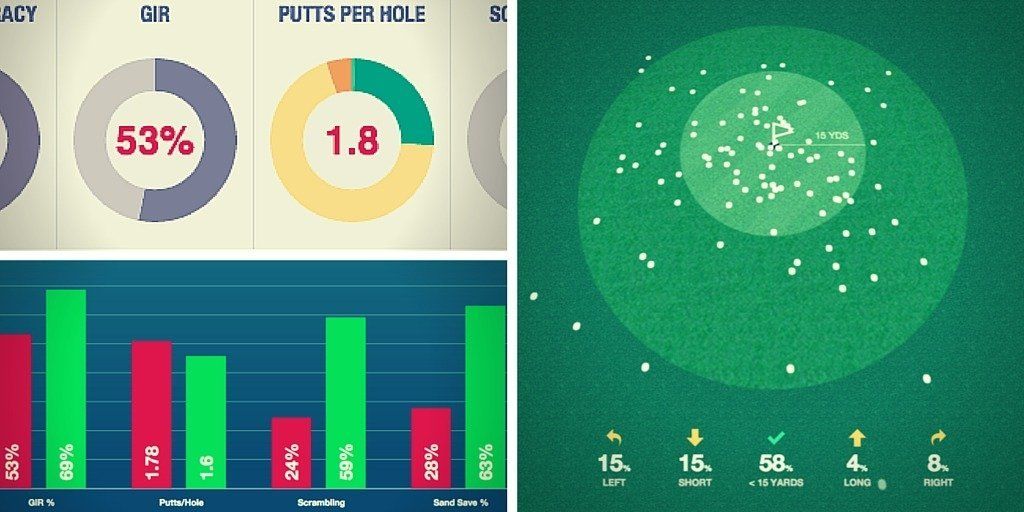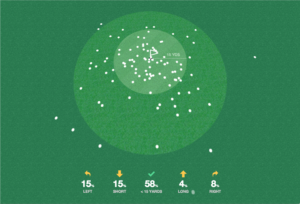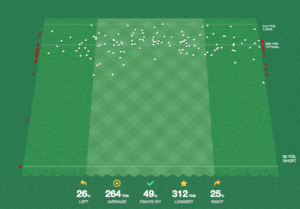
As 2016 kicks off, this is the ideal time to take a look back at 2015 and set some individual goals for this year.
If you are serious about improving as a golfer, the best way to do it is to set specific, measurable goals for yourself.
I’ve heard many people asking how they can use their stats to improve their game. I’d like to show you how using GAME GOLF can help you figure out how to enhance your strategy on the course, and show you where your game needs improvement.
More importantly, I want to show you how using statistical benchmarks can help you focus on achieving a specific goal.
Advanced stats have become an important part of the sports world in general, and are helping people make smarter decisions. Almost every single major sporting league has figured out a way to dive even deeper into the numbers, and adjust their approach. Golf is no different.
Let’s walk through an example of how this might pertain to a regular guy like me who is trying his best to improve.
My Year in Review
In 2014 my goal was to get my handicap below a 1.4 so I could compete in the U.S. Open qualifier the following year. I got all the way down to a .7, and was able to play in the tournament back in May. After shooting a 76, I felt an enormous sigh of relief, and felt great about how the entire process made me focus on improving my game.
Since then my game took a little step back for a few reasons. I may have gotten a little ahead of myself, and set my expectations too high. Additionally, I don’t think my on-course strategy was as sharp as it could have been.
I finished the year at a 2.3 handicap, and after tracking my rounds all year with GAME GOLF I want to take a look at what I need to do to get back to becoming as close to a scratch golfer as possible.
Keep in mind that this exercise will be specific to my game, and your stats could be completely different. But I think you will see how much you can uncover about your own game through this process.
Summary of my stats
I’ve logged 28 rounds with GAME GOLF for about six months, so I have a very accurate summary of my club distances and key statistics.

Taking a look at my top-level stats, I am not too disappointed in any of them. My fairway, greens in regulation, and putting look decent enough. However, I’ve got to dig a little deeper to see what I can be improving on the most to get my handicap closer to zero.
The best feature of GAME GOLF for an analysis like this is using the benchmark tool. I’ve compared my stats against those of scratch golfers. It’s clear that the two categories that are sticking out like a sore thumb are my greens in regulation, and my scrambling.
This tool can be used for any level of golfer you are looking to emulate, whether they are shooting in the low 80s or high 90s.

At my level I need to place more emphasis on hitting greens. I am only averaging 53% a round, and I have to get that number significantly higher in order to make more birdies and pars. My goal is going to be close to 70%.
My scrambling is significantly behind as well, and I will also need to fix this part of my game. However, if the goal is to hit more greens, and give myself a chance to make more birdies, my focus in this analysis is mostly going to be there.
A Deeper Look
Now that I have established that increasing my greens in regulation is my main focus, I need to take an even deeper look at my stats to see what is really going on.
How can I put myself in a position to hit close to 70% of my greens during the round?
Let’s take a look at my greens in regulation percentage from various distances, and see how efficient I am.
Here’s an example of what my shot dispersion is like from 150 – 175 yards, and a complete analysis of how many greens I hit from various distances.


If I plot my percentages you can see that from inside 100 yards I am hitting the green 84% of the time. As I go from 100-125 to 125-150, I remain consistent at 68%, which is right at my goal.
Here is where things get interesting. I drop to 58% at 150-175, and down to 50% at 175-200. As you would expect, my ability to hit greens goes below my target number as soon as I’m outside of 150 yards.
I also took a look at my percentages from the rough, as this will have to be part of the analysis. Inside 100 yards I am still hitting 75% of my greens, and I am at about 58-59% from 100-150 yards. My numbers drop, but not significantly.
It seems to be that 150 yards is the key number for me. I have to find a way to get myself inside of that number for my approach shots on par 4s and 5s, even if it is in the rough.
The only way to do that of course is to increase my distance off the tee.
Here’s the big question though: Can I do that without making big mistakes? Playing for more distance can become a slippery slope because it can lead to double and triple bogeys, which are absolute round killers.
I’ll need to look at my performance off the tee to see if that is a viable plan for me.
Tee Shot Analysis
I’ve been working really hard at improving my performance off the tee this year, especially with my driver. One area has been with my swing tempo, and it’s paid off very big.
I began 2015 terrified of my driver, and didn’t use it very much. I was only hitting about 20-30% of my fairways, and putting myself in bad situations because my misses were way off line. As a result, I was using my 3-wood and hybrid off of the tee in order to keep myself in play.
Things have changed though. I have become much more proficient with the big stick.

Taking a look at my percentages I am hitting 49% of fairways with my driver, 71% with my 3-wood, and 43% with my 3-hybrid. None of these numbers are that bad, and if you take a look back at the scratch player benchmark, I’m right in line with their fairway accuracy.
As a caveat, I rarely use my 3-wood off the tee so that fairway percentage is artificially high. If I used it as much as my hybrid I would probably see that number come down to the 45-55% region.
However, the most important thing here is my proximity to the hole.
Most par 4s I am playing range from 380-440 yards off the tee. This means my tee shots needs to be at minimum 230 – 290 yards in order to eclipse my cutoff of 150 yards. My typical distance with my driver is 268 yards, and drops down to 233 on the 3-wood, and 224 with my 3-hybrid.
Looking at the numbers, it would make sense for me to use my driver more on holes longer than 380 yards. I have a reasonable chance of hitting the fairway, and even if I am in the rough I have shown that I can still hit the green most of the time inside 150 yards.
How am I going to do it?
Now that I have established hitting greens is my biggest priority in 2016, I need to set a specific list of goals for myself in order to get there. It needs to be a mixture of my performance off the tee, club choice, and target selection. Here is what I am going to do.
- Smarter decisions on approach shots: I have either been too aggressive going at the pin, or have not taken enough club. My number one goal is to get on the green when I have an iron in my hand. Mentally I need to keep this in the forefront, and maintain my focus of getting as close to my goal of 70% greens hit. I have to get on the green at all costs, and forget about being aggressive!
- Driver accuracy: If I am going to be using my driver more off the tee, I need to improve my accuracy even more. My Golf Spy proved that using a shorter driver shaft will help with that. I either need to cut down my current shaft from 45 ½” inches to 43.75 – 44”, or possibly build a new one from scratch. Additionally, I will continue my work trying to hone my tempo as it has proven to be the key to keeping my ball in play more.
- Scrambling: I can’t forget my short game! My scrambling percentage needs to go up significantly. I will focus a huge part of my practice sessions to pitching/chipping and putts inside 10 feet (since I have the best chance of making those). This is one of the cornerstones of Practical Golf, and I would never leave my wedges and putter behind.
What does this mean for you?
The analysis I have just presented is specific to my game. I was only able to do it because I was tracking my stats all year with GAME GOLF, and it uncovered the truth about what was going on during my rounds. Adding the product to my routine was easy, and the information I now have at my disposal is extremely valuable.
Getting close to scratch is EXTREMELY difficult, and if you are trying to break 100 or 90 you might need to do the complete opposite of what my stats were telling me.
For example, if you found out that your scrambling percentage was close to zero, and a golfer you’re benchmarking yourself against had a significantly higher one, then it would be obvious you need to devote some time to your wedges.
Or you might have a putts-per-hole average significantly different than your goal, and it was obvious that three-putting was holding you back. That could be the low-hanging fruit of your game, and spending some time with your putter in your practice sessions could easily shave 3-4 strokes off your score.
The overall point is that you would never know where your game needs help if you weren’t keeping track. This is why I feel GAME GOLF has been one of the greatest pieces of technology that has come along for golfers in quite some time.
Establishing measurable goals, and keeping track of your progress is one of the greatest ways to improve at any endeavor, especially golf.
I’ve set my goals for to get back to scratch golf. I gave myself a few specific parts of my game to focus on, and I’ll be keeping track of them as the year goes on. Maybe doing the same for yourself could be your New Year’s Resolution?
We care about the protection of your data Read our Privacy Policy